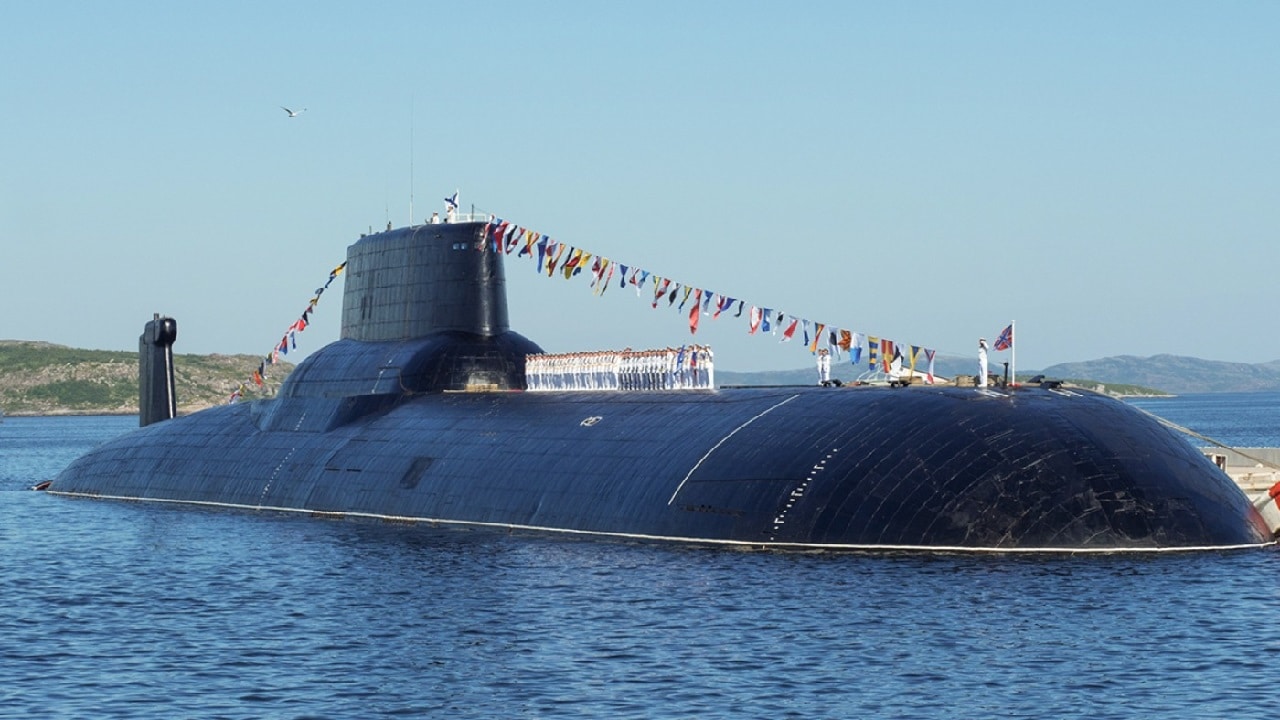Russia’s last active duty Typhoon-class ballistic missile submarine, the Dmitry Donskoy may be headed for retirement. At present, reports regarding the fate of the submarine are conflicting – and no official statement has been issued.
“RIA Novosti, citing anonymous sources, was the first to report that Dmitry Donskoy, also known by its hull number TK-208, had been formally decommissioned and was headed for the scrap yard,” Joseph Trevithick wrote for The War Zone. However, TASS has refuted the RIA Novosti report. “Anonymous sources from within Russia’s state-run shipbuilding industry and the country’s security services subsequently told TASS this this news was incorrect and that any final decision about the submarine’s future would not come until December at the earliest.”
Newsweek translated the TASS report. “Recent reports about the withdrawal of Dmitriy Donskoy from the Russian Navy do not correspond with reality,” one TASS source said. “The ship is currently performing combat training tasks at sea, participating in combat training activities. It will remain in combat formation at least until the end of the year.”
If the Typhoon is retired, it will relinquish its title as the largest submarine (by displacement) in the world. The Typhoon, which measures longer than a football field, displaces 48,000 tons and requires a 160 man crew to operate. The submarine’s staggering dimensions were designed during the Cold War, in reaction to America’s then-new Ohio-class submarine.
“When America unveiled its Ohio-class submarine, the Soviets were deeply concerned,” I wrote for 19FortyFive. “Each Ohio could carry 192 of the 100 kiloton warheads. The Soviets wanted to craft a proportionate response, something with equal destructive potential…the problem, however, was that the Soviet’s submarine-launched ballistic missile (SLBM), the R-39 Rif, was nearly double the size of its American counterpart, the UGM-96 Trident I.” So, to match the destructive potential of the Ohio, to match one R-39 for one UGM-96, the Soviets needed a submarine significantly larger than the Ohio. And the Ohio already displaced 19,000 tons.
“According to the U.S. Naval Institute, this massive disparity in size between the American and Soviet/Russian missiles is due to the differences in plastics industry maturity, which in the United States was able to create both plastic children’s toys, as well as important binders for solid-fuel missile components,” my colleague explained for 19FortyFive.
The Soviet’s solution, the Typhoon, is absolutely massive; it displaces 250 percent more than the Ohio. The Typhoon wasn’t just long – it was wide, thanks to the multiple pressure hulls. The pressure hulls were a safety feature that significantly increased the crew’s survivability.
Only six Typhoons were ever built. Today, only one, the Dmitriy Donskoy, remains in service. Oddly enough, the Dmitriy Donskoy was the first Typhoon-Class built; launched in 1979, the sub has outlived its younger siblings.
The news that the last Typhoon-class may be headed for the scrap heap is not a surprise. The sub is “clearly in the twilight of its career.” I wrote. “Used only in a limited, weapons testing role, the Dmitriy Donskoy is not expected to remain in service much longer than 2026. The world’s biggest ever submarine will be decommissioned and scrapped, like the other five Typhoon-class submarines, in favor of the Borei-class sub – a smaller sub that displaces just 24,000 tons, yet carries plenty of firepower: 16 Bulava SLBMs.”
The Typhoon is not the longest submarine in the Russian Navy’s inventory. That distinction belongs to the K-329 Belgorod, which measures 603 feet long (about 40 feet longer than the Typhoon). The Belgorod only displaces 30,000 tons, however. When the Typhoon is finally retired, the Belgorod will be the largest submarine in the Russian inventory.
Fortunately, the Typhoon was never tasked with delivering its nuclear payload; most of the submarine’s service was after the end of the Cold War. The Typhoon remains an iconic symbol of the Cold War, however; The Typhoon is best remembered for its inclusion in Tom Clancy’s classic novel The Hunt for Red October. The film adaptation was a hit, starring Alec Baldwin as the first in a long line of prominent actors to portray CIA analyst Jack Ryan. Baldwin stars across Sean Connery, who portrays the Typhoon’s commander.
Regardless of whether RIA or TASS’s conflicting reports are accurate, the Typhoon-class is most assuredly at the end of its service run.
Harrison Kass is the Senior Defense Editor at 19FortyFive. An attorney, pilot, guitarist, and minor pro hockey player, he joined the US Air Force as a Pilot Trainee but was medically discharged. Harrison holds a BA from Lake Forest College, a JD from the University of Oregon, and an MA from New York University. He lives in Oregon and listens to Dokken. Follow him on Twitter @harrison_kass.

